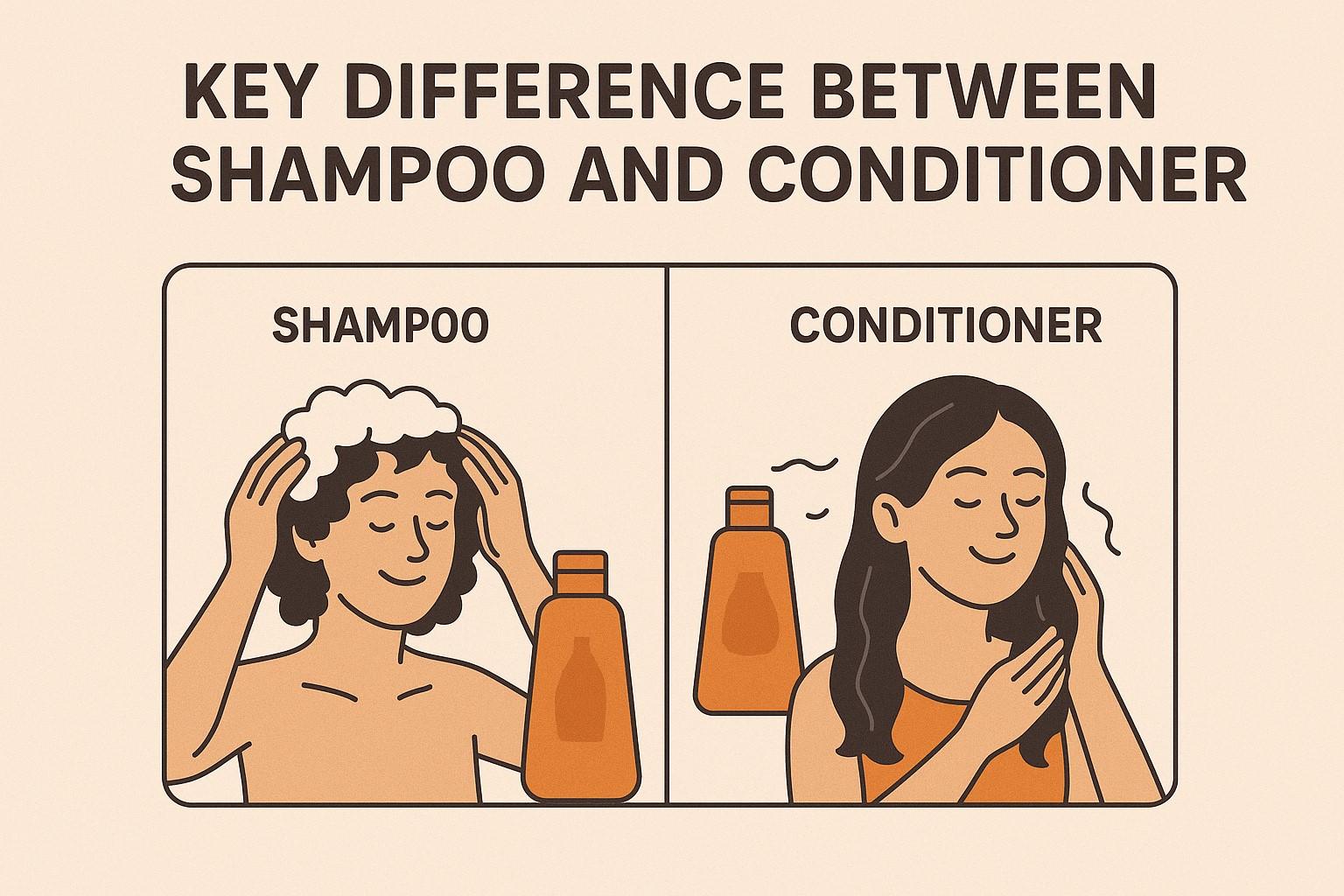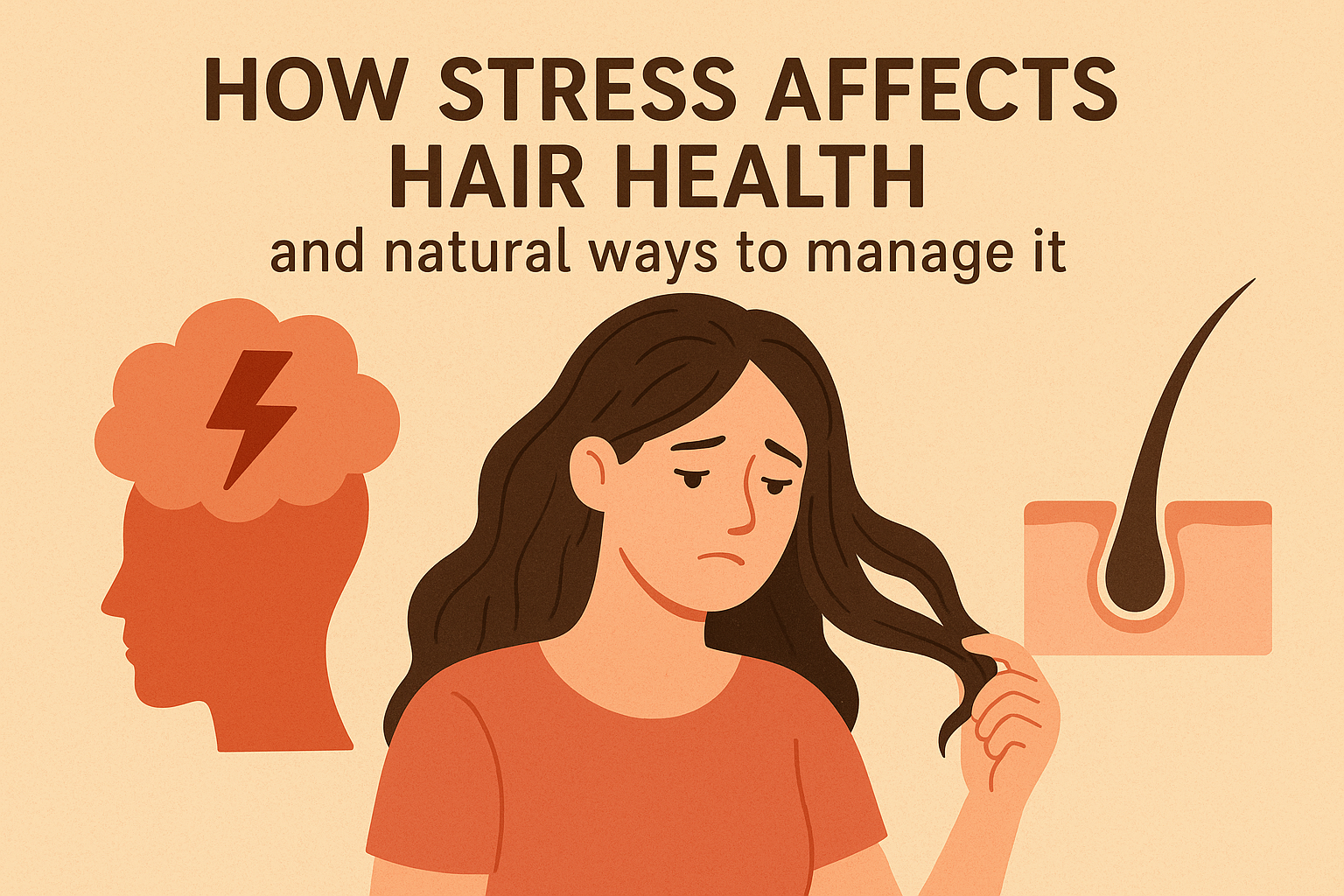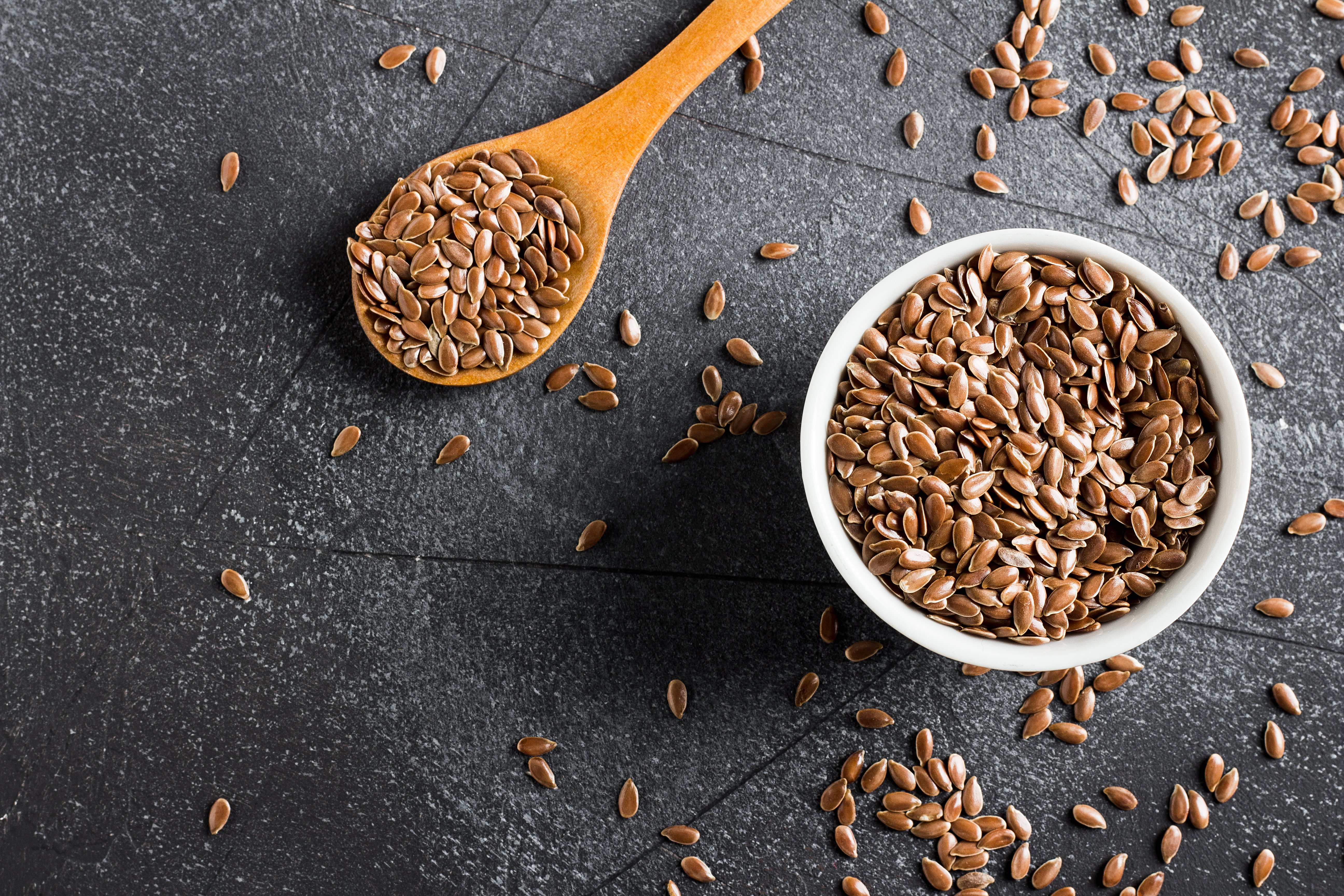When individuals ask, “What is the difference between shampoo and conditioner?” they’re really asking about the special contributions these two products make toward having healthy hair. Shampoo is really used to wash the scalp and hair by stripping away dirt, oil, and product residue. Conditioner, in contrast, is used to restore moisture, calm the hair shaft, eliminate frizz, and guard strands against damage.
Shampoo cleanses the hair as a pre-treatment step, followed by the conditioner to restore and safeguard. Skipping either process harms your hair’s health, over-shampooing without conditioning is drying, and conditioning without shampooing is a buildup. Both are unique but complementary parts of an overall hair care regimen.
Anyone who must have soft, easy-to-handle, and well-conditioned hair needs to know their roles.
Also Read: Hard Water On Damaged Hair
What Does Shampoo Really Do for Your Hair?
Shampoo is a hair product designed to wash hair, usually in liquid or solution form, whose purpose is to remove sebum, dirt, sweat, dead skin debris, and product buildup from the scalp and hair. Its potency lies in that it is able to use surfactants, molecules that are water-attracting as well as oil-attracting, making oil-based contaminants emulsifiable and washable.
The main purpose of shampoo is to wash the scalp thoroughly and facilitate good hygiene. Common constituents in shampoos are surfactants such as sodium lauryl sulfate (SLS), sodium laureth sulfate (SLES), and cocamidopropyl betaine, preservatives, thickeners, fragrances, and natural extracts such as aloe vera, tea tree oil, and jojoba oil.
Regular use of harsh shampoos will remove the natural oils of the hair, lift the cuticle, and lead to dryness, irritation, or brittleness.
Types of Shampoos
1: Sulfate-Free Shampoos: Gently treat the scalp, and are perfect for color-treated or sensitive locks.
2: Clarifying Shampoos: Remove deep-rooted buildup; perfect for use now and then.
3: Moisturizing Shampoos: Loaded with moisture-rich ingredients to combat dryness.
4: Volumizing Shampoos: Designed to give thin or fine locks body and lift.
5: Anti-Dandruff Shampoos: Encompass active ingredients such as zinc pyrithione or ketoconazole to control flaky or itchy scalps.
What Is a Conditioner And Its Types?
Conditioner is a hair care product available in cream, lotion, or gel form, which is used to replace moisture, soften the cuticle of the hair, decrease friction, shine, and improve manageability. Conditioner accomplishes this by creating a protective barrier around the hair shaft that strengthens and safeguards the strands from damage caused by external factors.
The conditioner’s key function is to moisturize the hair after shampooing and close the raised cuticle in the wash cycle. This softens, smoothes, and makes hair less knotty. Conditioners are usually made up of cationic surfactants, silicones (dimethicone), natural oils (argan, coconut, and shea butter), fatty alcohols (cetyl and stearyl), proteins and amino acids (keratin and silk proteins), and humectants (glycerin and panthenol).
Ingredients cling to the negatively charged parts of the hair and remove static, smooth the cuticle, and seal in moisture.
Types of Conditioners
1: Rinse-Out Conditioners: Applied after each shampoo to replenish moisture.
2: Deep Conditioners: Richer and more intense, applied weekly for heavy-duty moisturizing.
3: Leave-In Conditioners: Offers long-lasting hydration and frizz management throughout the day.
4: Protein Conditioners: Replenishes and re-links damaged or broken hair.
5: Color-Protect Conditioners: Designed to maintain color-treated hair and keep it looking vibrant.
Also Read: Hair Care Routine For Frizzy Hair
Difference Between Shampoo and Conditioner
| Aspect | Shampoo | Conditioner |
| Function | Cleans by stripping oil, dirt, and product residue | Moisturizes by hydrating, detangling, and smoothing hair |
| Mechanism | Surfactants cuticle-open and emulsify waste | Cationic products neutralize the charge and close the cuticle |
| Hair Effect | Leaves hair porous, dry, and frizzy | Smoothes strands, gives shine, and reduces friction |
| Application Area | Affects the scalp and roots | Applied mainly to mid-lengths and ends |
| Frequency | Daily to bi-weekly, depending on hair type and lifestyle | Used after every shampoo or more often for dry/damaged hair |
| Potential Risk | Overuse can strip natural oils, leading to dryness and irritation | Overuse causes weight and oiliness, particularly on fine hair |
Why the Conditioner Step Is Important
Shampooing lifts the hair cuticles, so the strands are more vulnerable to environmental stress, drying out, and rubbing. That’s when conditioner comes to the rescue:
1: Closes the cuticle, keeping moisture in and dirt out
2: Restores the lipid barrier to help counteract dryness
3: Sleek texture diminishes friction and breakage
4: Replaces proteins and vital nutrients stripped away by shampooing
Expert advice identifies conditioner as necessary to keep overall hair texture smooth, glossy, and resistant to breakage. Cosmetic dermatology research indicates that regular use of conditioner greatly improves elasticity and tensile strength.
Should You Use Shampoo or Conditioner First?
Standard Method
The most ancient and best-accepted technique is to shampoo first. Shampoo cleanses the hair and scalp of dirt, oil, and product residue and lifts the cuticle of the hair. This prepares the hair for the next step of conditioning, which moisturizes the hair shaft, seals the cuticle, and delivers softness, shine, and manageability.
Alternative Methods
1: Reverse Washing: It is obtained by the use of conditioner prior to shampoo. It’s most commonly applied to fine or oily hair to keep the hair from getting too heavy or oily when being washed.
2: Co-Washing: A shorter version of “conditioner-only washing,” co-washing doesn’t use shampoo at all. It’s a gentle wash that is best liked by curly, coily, or dry hair textures who desire to lock in moisture.
Expert Recommendation
While co-washing helps with hydration, it doesn’t deeply cleanse the scalp. Dermatologists recommend using a traditional shampoo at least once a week to maintain scalp health and prevent buildup.
Also Read: Hair Care For Seasonal Hair Fall
Step-by-Step Guide: Maximizing Both Products
A proper hair care routine can significantly improve your hair’s texture, strength, and appearance. Follow this step-by-step guide to make the most of your shampoo and conditioner:
1: Wet Your Hair Properly: Start by wetting your hair thoroughly with lukewarm water. This will open up the cuticle of the hair and make it absorbent to shampoo properly.
2: Apply Shampoo: Take a small, coin-sized quantity of shampoo in your hands. Apply the shampoo especially on the scalp and roots where oil and dirt get collected the most.
3: Massage Gently: Gently massage the shampoo with your fingertips (not nails) in a circular motion. This aids in circulation and enables the breaking down of excess oil and dirt.
4: Rinse Thoroughly: Take care to rinse the shampoo from your hair thoroughly until the water runs clear. Insufficient rinsing can lead to residue being left behind, which leads to buildup or irritation.
5: Squeeze Out Excess Water: Squeeze out the excess water from your hair. A conditioner is best applied to damp hair.
6: Apply Conditioner: Apply conditioner to the mid-lengths and ends of your hair. Avoid applying to the scalp unless your scalp is very dry. Apply with a wide-tooth comb, evenly.
7: Leave it in for 2–5 Minutes: Leave it in for a few minutes so that it penetrates well and conditions the hair shaft.
8: Rinse With Cool Water: Wash thoroughly with cool or warm water to close the cuticle and impart shine.
9: Dry Gently: Gently pat your hair dry using a microfiber towel or an old T-shirt to minimize frizz and breakage.
10: Use Leave-In Products (Optional): Use a leave-in conditioner or heat protectant to shield your hair against styling tools or the environment.
How Shampoo and Conditioner Affect Hair Porosity
Hair porosity is a fancy way of saying how easily your hair soaks up and holds on to water. Some people’s cuticles lie flat and resist moisture; others have gaps where water and products slip in too quickly. Shampoos and conditioners affect this balance more than most realize.
A strong shampoo, especially one with a higher pH, can lift the cuticle layer. That makes hair more porous, which can be good if you’re trying to get treatments to sink in, but it also makes strands prone to frizz and dryness. Conditioners usually do the opposite. Their slightly acidic nature helps smooth the cuticle back down, making hair feel softer and shinier.
If your hair is low-porosity, meaning the cuticle is very tight. Heavy butters and oils will probably just sit on top. Light, water-based products work better. On the flip side, high-porosity hair benefits from richer conditioners and sealing oils because it loses moisture quickly.
What Happens If You Skip Conditioner?
Shampoo alone cleans, but it doesn’t replace the protective coating your strands lose in the process. Skip conditioner and you’ll notice hair getting rough, harder to detangle, and more likely to break. Ends, in particular, dry out fast.
It’s not just about appearance either. Without conditioner, the cuticle stays slightly raised, which means friction every time you brush or sleep. Over weeks, that wear adds up. Even if you prefer lightweight hair, a small amount of conditioner on the lengths can make all the difference.
Ingredients to Avoid in Shampoo and Conditioner
Some ingredients cause more harm than help:
- Sulfates: These are harsh detergents that strip oil. They make shampoo foam well, but also dry out the scalp.
- Silicones: They add shine, but they can build up over time, especially on low-porosity hair, leaving it heavy or dull.
- Drying alcohols: Short-chain types like isopropyl alcohol evaporate fast and take moisture with them. Fatty alcohols (cetyl, stearyl) are different—they’re actually good for softness.
When in doubt, check labels. If your hair always feels coated or rough no matter what, the ingredients may be the culprit.
How Often Should You Wash and Condition Your Hair: By Hair Type
There’s no single rule because scalp oil, texture, and porosity all matter. Still, here’s a guide to keep things simple:
- Fine or straight hair: Wash every 1–2 days. It gets oily faster, so skipping for too long can make it flat. Conditioner should be very light, focused only on the ends.
- Wavy hair: Every 2–3 days is usually enough. A mid-weight conditioner keeps waves defined without weighing them down.
- Curly hair: Once or twice a week. Curls are naturally drier, so frequent washing strips the oils. A conditioner is non-negotiable.
Coily hair: Weekly or even every 10 days. Gentle cleansers and deep conditioners are key here to keep strands from becoming brittle.
Common Mistakes to Avoid
1: Over-Shampooing: Removes natural oils from hair, leaving hair dry and an irritated scalp.
2: Skip Conditioning: Increases frizz, tangling, and breakage.
3: Scalp Conditioning: Can clog pores and cause buildup or greasiness.
4: Applying Too Much Product: Weighs hair down, particularly on fine or thin hair.
5: Incorrect Use of Product: Using the shampoo or conditioner that is not right for your hair can damage your hair or make it ineffective.
Medical & Scientific Insight
1: pH Level: Shampoos are more alkaline (pH 5.5 to 7), which cleans the scalp but lifts the hair cuticle. Conditioners are more acidic (pH 3.5 to 5.5), which presses the cuticle down, smooths frizz, and locks in moisture.
2: Hair Biology: The cuticle, the surface layer of the hair, is highly sensitive to pH and to rubbing. When not conditioned, hair is weakened, dried out, and prone to split ends.
3: Clinical Evidence: Clinical tests have shown that regular use of conditioner can strengthen hair tensile strength, improve shine, and reduce combing damage by up to 50%.
Natural Alternatives & Add-Ons
Natural products may be added to help hair health, but in no way as a substitute for daily shampoo or conditioner.
1: Argan Oil & Coconut Oil: Fatty acid and antioxidant-rich, these oils are great for moisturizing, repairing, and enhancing the elasticity of hair. Use as a pre-wash treatment or a light post-wash serum.
2: Aloe Vera Gel: Calming and moisturizing, aloe vera soothes the scalp and hydrates dryness, ideal for sensitive or irritated scalps.
3: Apple Cider Vinegar Rinse: Balances the natural pH of the scalp, removes product buildup, and provides shine. Mix with water first.
4: Shea Butter: Very moisturizing, especially for curly or textured hair. Provides softness and increases moisture hold.
5: Essential Oils (Lavender, Tea Tree): Encourage scalp health, combat flakiness, and provide a natural, pleasant scent.
These are added protection but to be put over, not in place of, your standard hair care product.
Conclusion and Takeaway Tips
Understanding what is the difference between shampoo and conditioner is key to building an effective hair care routine. Shampoo is formulated to cleanse the hair and scalp by stripping away dirt, oil, and product residue. Shampoo is to be used 1 to 3 times per week, based on hair type, to prevent drying out the hair. A conditioner needs to be applied after each shampoo.
A conditioner hydrates the hair, eliminates frizz, closes the cuticle, and allows the hair to become manageable. For optimum performance, cleanse products thoroughly and utilize paraben-free, sulfate-free products, particularly if you’re a colored hair or sensitive skin individual.
Even oily hair needs conditioner at the mid-lengths and ends, so that it’s evenly moisturized. Both products, if applied properly, not only make you clean but also lead to healthier, stronger, and more radiant hair with the passage of time.
Also Read: Expert Tips On Brushing Your Curly Hair
FAQs
Can I produce my shampoo or conditioner at home?
Yes, shampoos can be made at home using things such as baking soda, apple cider vinegar, or castile soap. Avocado, yogurt, honey, or banana are mixed to prepare conditioners. These do not contain proper pH balance or preservatives and hence might trigger irritations to the scalp or spoil easily.
Does the temperature of water play a role in the use of shampoo and conditioner?
Yes. Lukewarm water opens up the hair cuticle and strips away oil efficiently. Cold water used as the last rinse locks in the cuticle and provides hair with a shine. Hot water dries out hair by stripping it of natural oils.
Are men’s and women’s hair care products different?
In general, the purpose is the same. Men’s may contain menthol or caffeine, and women’s might contain softness or color protection. Use according to your hair type, not sex.
Do conditioners and shampoos go bad?
Yes. They primarily go bad within 12–24 months of opening. Indicators are odour, texture, or colour changes. Past their shelf life, these products may cause irritation to your scalp or decrease performance.
Should I not use products containing alcohol?
Stay away from short-chain alcohols such as ethanol or isopropyl alcohol, which dry out. Fatty alcohols such as cetyl or stearyl alcohol are good for you, they condition and soften hair.
What is a 2-in-1 shampoo and conditioner?
They do everything in one bottle. They’re easy to apply but might not condition so well. Great for short, low-maintenance hair.
Does hard water impact performance?
Yes. Hard water minerals will strip lather and create buildup. Try clarifying shampoo occasionally or fit a water softener to achieve better results.
Can conditioner repair split ends?
It will moisturize and conceal split ends for the short term, but won’t repair them. Trimming frequently and conditioning will halt the damage from going further.
Is it okay to shampoo color-treated hair?
Yes, provided you use color-safe, sulfate-free products. Periodic use of deep conditioners to extend color.
How does scalp health influence hair care?
A healthy scalp guarantees healthy growth. Shampoo to cleanse and condition to restore lengths. For problems such as dandruff, use specific scalp treatments.
Can I use shampoo daily without conditioner?
You can, but your hair will probably feel dry and static-prone. Even a small amount of conditioner on the ends helps prevent this.
Will using both products weigh down fine or oily hair?
It can, if the formulas are heavy. Choose lightweight, silicone-free products and keep conditioner away from the roots.
Is it safe to use shampoo and conditioner on your beard or body?
They’ll clean, but they’re not designed for skin or facial hair. Beard and body products are gentler and usually better suited.
Can conditioner cause scalp acne or irritation?
Yes, if applied directly on the scalp. Residue can block pores or mix with oil, leading to bumps or flakes. Keep it on the lengths.
Does size or frequency of product application matter?
Definitely. Too much shampoo strips oils; too much conditioner builds up. Adjust based on your hair length and thickness. A little usually goes further than you think.


